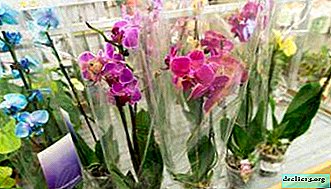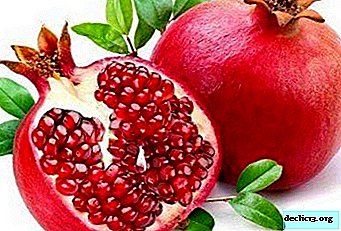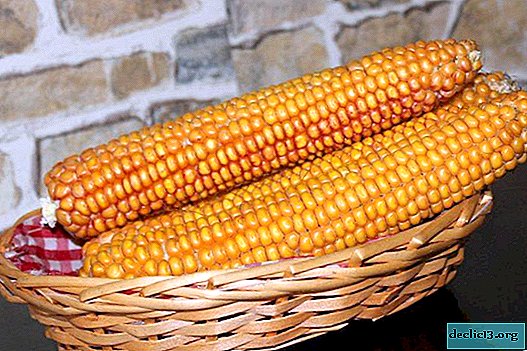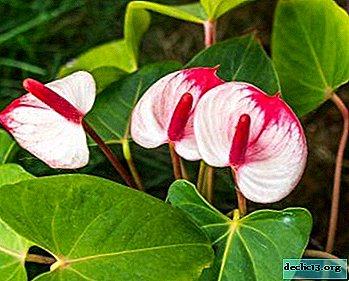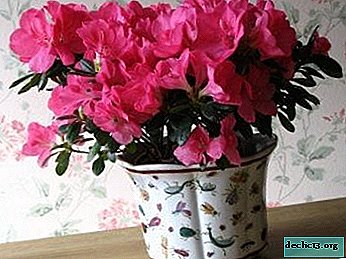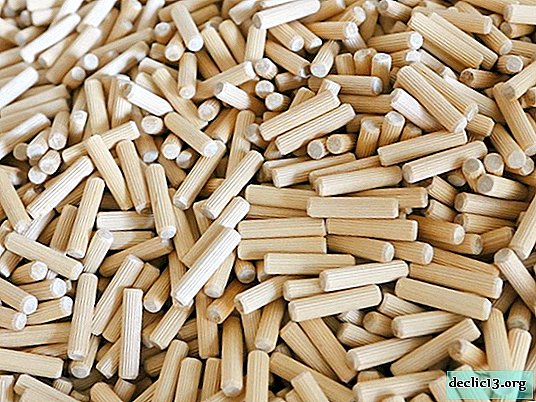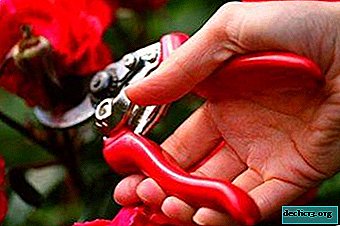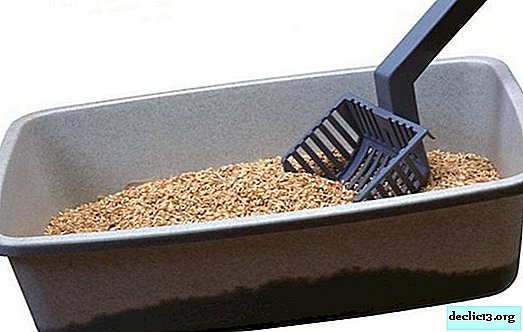Blooming wisteria - decoration of the garden: everything you need to know about the plant
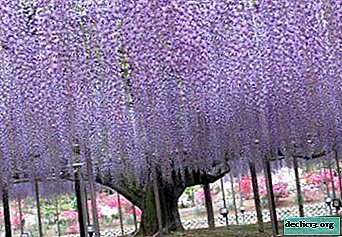 Many landscape designers and gardeners have long noticed such an incredibly beautiful plant as wisteria. And it is not in vain that, seeing once, it is difficult to remain indifferent to clusters of flowers and a wonderful aroma.
Many landscape designers and gardeners have long noticed such an incredibly beautiful plant as wisteria. And it is not in vain that, seeing once, it is difficult to remain indifferent to clusters of flowers and a wonderful aroma.
A huge waterfall of bright inflorescences amazes even the restrained Japanese, who call the garden with wisteria a paradise. In the article you can find a description of the plant, find out whether it is a shrub, the history of the plant, the nuances of care, whether the wisteria is poisonous or not, and also see its photo.
Description of wisteria: what kind of plant does it look like, is it a bush?
Wisteria - perennial climbing deciduous vinehaving a trunk and a woody form, a representative of the legume family, showing the peculiarity of stretching long shoots, entwining various supports. Although many people think that wisteria is a tree or shrub.
Species of tree-like tall subtropical plants with large tassels of fragrant lilac flowers. The genus has 9 varieties. However, only 2 of them are popular: Japanese wisteria (plentifully flowering) and Chinese wisteria.
Another common name is Wisteria. (lat.Wistéria). The Wisteria received the Latin name in honor of Caspar Wistar, who was an anatomy professor at the University of Pennsylvania.
The plant reaches a height of 20 meters, the inflorescences are also quite large - 15-20 cm. The leaves are rather large, unpaired, consist of 7-13 small leaves. It grows quickly - up to 20 cm per season.
Despite the magnificence, the liana is dangerous if you do not know all the features. Wisteria is poisonous, so do not plant it near water. These delicate flowers with purple and white tassels hanging over the pond are poisonous and pose a threat to its inhabitants.
Poisoning can be caused if the fruits, flowers or leaves of Wisteria are eaten. This meal can cause diarrhea, colic, dizziness, and even vomiting. Seeds are especially dangerous. They are recommended to be collected without leaving in the area where children or pets are often found.
Photo
Here you can find photos of wisteria and closeup photos of flowers:





Where does it come from and where does it grow?
Southeast Asia is considered the birthplace of wisteria. In China, inhabits the forests of the provinces of Hubei and Sichuan, loved and respected by the inhabitants. Gained worldwide popularity as an ornamental plant. Wild species are found throughout America. American breeders have made a significant contribution to the development of frost-resistant varieties. In more detail about the types and varieties of wisteria we talked about in a separate material.
The greatest decorative qualities are revealed in a warm humid climate, therefore it is popular in Europe and in the south of Russia. On the territory of Russia it grows in the Crimea, Moldova and Uzbekistan. In Transcarpathia and the Caucasus, it blooms very densely and continuously. It blooms farther north and requires winter shelter.
What does it smell like and what does it smell like?
Among other things wisteria has a delicate sweet aroma, slightly giving off honey, for which she received the name (from Greek - sweet). It is also used in perfumes. The note of wisteria is not new, although it is not common, mainly due to the similarity with the aroma of lilac.
Care
Liana prefers light soil, saturated with nutrients and moisture. In drought, plants should be well watered, this is necessary for the formation of buds. During the period of budding and flowering once a week, it is strongly recommended to feed with liquid fertilizer.
Reference! For more lush flowering, wisteria should be in the sun at least noon. They require shelter for the winter. Some varieties withstand frosts to -20C.We wrote more about wisteria care here, and here you can find out when and how to trim this plant.
Cultivation and reproduction
Wisteria can be grown from seeds, cuttings and cuttings.
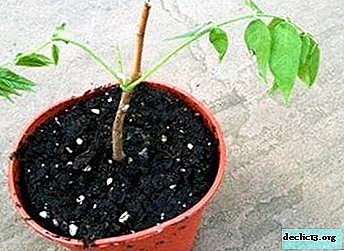 Seeds are sown in early spring to a depth of 2 - 3 cm and covered with a film or glass. The soil must contain humus and some sand.
Seeds are sown in early spring to a depth of 2 - 3 cm and covered with a film or glass. The soil must contain humus and some sand.Seeds break out in the gloom at an air temperature of 20 - 25C for a month, then they should be taken out to a lighted place, carefully dive, without violating the young root system. After that, you can plant grown plants in open ground, covering the winter with fir branches, foliage or sawdust.
- To grow a powerful beauty with the help of layering, you will need to take a one-year-old shoot in early spring, make an incision in the middle, and place this place in nutrient soil. The top of the stem should remain free.
To increase the rooting, lightly fertilize the ground with the container. By the end of the season, many roots will form on this place, and the shoot can be safely planted as an independent plant.
- Another convenient method can be called cuttings. In late autumn, after the leaves have fallen, annual cuttings are harvested. Everyone is required to contain 2-3 internodes. The branches are bandaged in a small bundle and immersed in a container with a moist substrate.
In March-April, cuttings are taken out and planted in a greenhouse or immediately in open ground. All branches are covered with plastic caps. The cap is removed when the stalk is taken and the kidneys open.
More details about the cultivation and planting of wisteria are described here.
Bloom
Wisteria flowers bloom at the same time as leaves appear, or a little earlier. With good care the plant blooms profusely in March and again in late summerbut weaker. When the flowers of the wisteria begin to fade, it is recommended to remove the inflorescences, which are completely pepper,. After resetting the flowers, it actively braids all kinds of frames and facades.
We suggest you watch a video about the flowering of wisteria:
Pests and diseases
 Wisteria is quite resistant to parasites, due to its toxic properties. However, chlorosis does not pass by, arising from calcareous and clay soil. Leaves brighten and turn yellow. Fertilizing with iron salts helps to resist the development of chlorosis.
Wisteria is quite resistant to parasites, due to its toxic properties. However, chlorosis does not pass by, arising from calcareous and clay soil. Leaves brighten and turn yellow. Fertilizing with iron salts helps to resist the development of chlorosis.
Wisteria and pathogens are affected, for example, renal pyriculariosis, which infects flower buds. Outwardly, it seems that they are covered with dark mold. When the pathogen is made public, it is necessary to cut off the diseased branches and burn them to stop the spread of infection. At the end of summer, it is recommended to treat the plant against the pathogen.
Aphids are also actively attacking the plant. You can notice this by sticky honey dew and a crooked shoot. An insecticide will help to get rid. Spray will be required twice, the second procedure is repeated after 10 days.
Important! Another enemy of Wisteria is considered a clover tick. When a bronze hue appears on the leaves, know this is it. You can fight both folk remedies - garlic tincture - and an insecticide. Spraying is carried out with an interval of three weeks.Interesting facts about liana
- The Japanese flower garden has a wisteria tunnel.
- Hanging brushes can reach up to 80 cm.
- With growth, it spins in a spiral.
- The 144-year-old wisteria growing in Japan is considered the largest among its species.
- Wisteria can be grown in a house or apartment as a home indoor flower in the form of a bonsai.
Similar flowers
- Bobovnik Golden Rain.
The representative of the legume family in the form of deciduous tree. By mid-May, golden racemose blossoms bloom on long pods (20-50 cm). Exudes a sweet aroma, luring insects to collect nectar. It blooms very plentifully.
- Acacia.
Evergreen tree, the height reaches 25 meters. Belongs to the Legume family. The bark of young specimens is smooth, greenish, after a while it darkens and cracks appear. Inflorescences are used as decoctions and tinctures, taking both inside and rubbing.
- Gray spirea.
Hybrid shrub. It has a branchy structure with felt branches. Height about 2 m. Leaves are pointed grayish-green, in places lighter. Inflorescences are located on long branches. Flowering begins in May, by the end of June, the spirea ripens. Compact bush thanks to the falling branches with snow-white flowers.
- Robinia hairy.
Shrub up to 3 m high. It has no thorns, is covered with orange bristles, which fall over time. The flowers are pink and large, have no smell.
It is generally accepted that wisteria is a whimsical exotic plant that grows abroad, but it is worth delving into its study, as everything becomes simpler. Unpretentious in care, Wisteria will certainly please the eye of any fastidious gardener. Observing the basic rules of care, you can achieve annual lush flowering.

 Seeds are sown in early spring to a depth of 2 - 3 cm and covered with a film or glass. The soil must contain humus and some sand.
Seeds are sown in early spring to a depth of 2 - 3 cm and covered with a film or glass. The soil must contain humus and some sand.